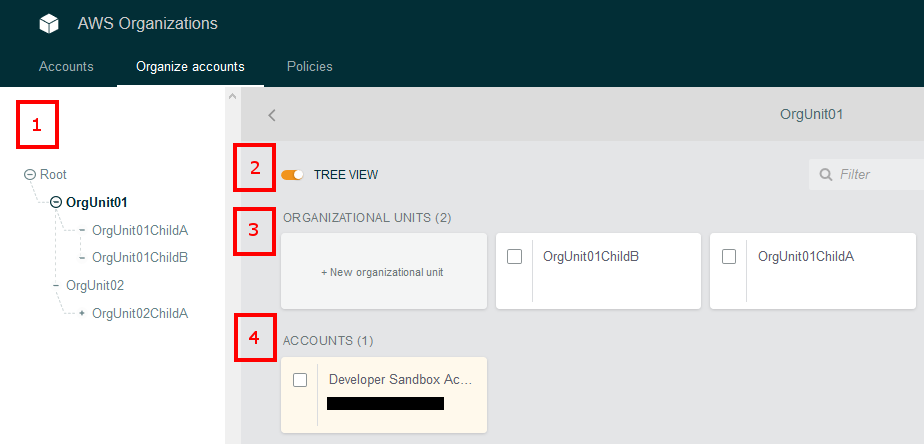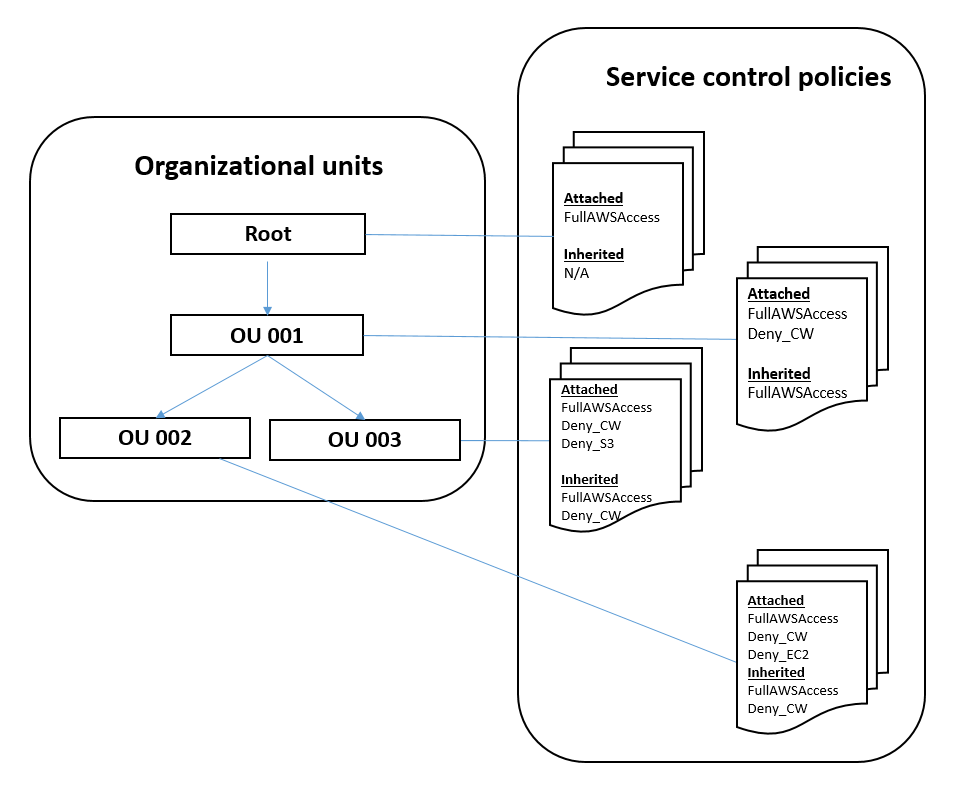AWS Security Blog
How to Use Service Control Policies in AWS Organizations
January 20, 2020: Based on customer feedback, we rephrased the fourth goal in the “An example structure with nested OUs and SCPs” section to try to improve clarity.
With AWS Organizations, you can centrally manage policies across multiple AWS accounts without having to use custom scripts and manual processes. For example, you can apply service control policies (SCPs) across multiple AWS accounts that are members of an organization. SCPs allow you to define which AWS service APIs can and cannot be executed by AWS Identity and Access Management (IAM) entities (such as IAM users and roles) in your organization’s member AWS accounts. SCPs are created and applied from the master account, which is the AWS account that you used when you created your organization.
In a previous post, How to Use Service Control Policies in AWS Organizations to Enforce Healthcare Compliance in Your AWS Account, we reviewed how to create and manage SCPs and Organizational Units (OU) within an organization. In this post, I show how to use SCPs for access control in Organizations, with a specific focus on evaluating SCPs when an IAM entity calls an API in a member AWS account. I first cover some key Organizations concepts, and then I show how an SCP attached to an organization impacts which AWS service APIs are available to member accounts. Finally, I demonstrate these concepts with an example.
Organizational structure in Organizations
OUs give you a way to logically group and structure member AWS accounts in your organization. The screenshot shows the tree view of an example organizational structure in my organization with several OUs. Currently, I have selected OrgUnit01, and this is the current view I see in my main window. You can see here that within the OrgUnit01 OU, I have nested two additional OUs (OrgUnit01ChildA and OrgUnit01ChildB) and an AWS account is also contained within OrgUnit01, named “Developer Sandbox Account”.

The parts of the example organizational structure in the screenshot are:
- Tree view — The hierarchy of your organization’s root and any OUs you have created
- Tree view toggle — Enable and disable tree view
- Organizational Units — Any child OUs of the selected root or OU in tree view
- Accounts — Any AWS accounts (members or master) in the current OU
In the next section, I explain why at least one SCP must be attached to your root and OUs and introduce SCP evaluation.
How Service Control Policy evaluation logic works
To allow an AWS service API at the member account level, you must allow the API at every level between the member account and the root of your organization. This means you must attach an SCP at every level between your organization’s root and the member account that allows the given AWS service API (such as ec2:RunInstances). For more information, see About Service Control Policies.
Let’s say you want to allow the ec2:RunInstances API in the Developer Sandbox Account in the example structure in the preceding screenshot. To allow this AWS service API, you must allow the API in at least one SCP attached at each of these levels:
- The organization’s root
- The OU named
OrgUnit01
If you don’t allow the AWS service in an SCP attached at each of these two levels, neither IAM entities nor the root user in the Developer Sandbox Account will be able to call ec2:RunInstances, even if an administrator has given them permission to do so (for IAM entities). In terms of policy evaluation, SCPs follow exactly the same policy evaluation logic as IAM does: by default, all requests are denied, an explicit allow overrides this default, and an explicit deny overrides any explicit allows.
What does this look like in practice? In the next section, I share a practical example to demonstrate how this works in Organizations.
An example structure with nested OUs and SCPs
In the previous section, I introduced design aspects of AWS Organizations that help prevent administrators from breaking structures in their Organizations. But because AWS Organizations is flexible enough to address multiple use cases, administrators can make changes that have unintended consequences, such as breaking organizational structures when moving an AWS account from one OU to another. In this section, I show an example with broken OU and SCP structures and explain how you can fix them.
I’ll use a deny list technique. That is, I’ll use the FullAWSAccess SCP, which doesn’t filter out any AWS service APIs. Then, I will filter out specific APIs by deny listing them in subsequent SCPs attached to OUs at various points in my organization’s structure. For further reading on deny lists and allow lists in AWS Organizations, review AWS Organizations Terminology and Concepts.
Let’s say I have developed the OU and SCP structure shown in the diagram below. Before taking a close look at that diagram, I’ll briefly outline the goals I’m trying to achieve. Broadly speaking, there’s a small subset of APIs that I want to filter out using SCPs. This means that IAM entities in some AWS accounts in my organization will not have access to particular AWS service APIs, such as those related to Amazon EC2, while other accounts will not have access to APIs associated with Amazon CloudWatch, Amazon S3, and so on. Apart from these special cases, I do want the accounts in my organization to have access to all other APIs. More specifically, my goals are as follows:
- Any AWS accounts in the Root should not have any API filtered out.
- Any AWS accounts in OU 001 should have APIs for CloudWatch filtered out, but all other APIs will be accessible.
- Any AWS accounts in OU 002 should have APIs for both CloudWatch and EC2 filtered out, but all other APIs will be accessible.
- Any AWS accounts in OU 003 should have APIs for S3 and CloudWatch filtered out, but all other APIs will be accessible.
To that end, let’s now look at my initial SCP and OU configuration in the image below that shows the example OU and SCP structure. The arrow shows the direction of inheritance: the root and the OUs below it (children) inherit SCPs from the OUs above them (parents). This example structure contains the following SCPs:
FullAWSAccess— Allows all AWS service APIsDeny_CW— Denies all CloudWatch APIsDeny_EC2— Denies all Amazon EC2 APIsDeny_S3— Denies all Amazon S3 APIs

Now that I’ve outlined my intent, and shown you the OU / SCP structure that I’ve created to meet that set of goals, you can probably already see that the structure provided in the image above will not work correctly for my stated goals. In fact, AWS accounts in the Root container and OU 001 will have the intended access, as per my goals (1) and (2). I will not, however, meet my goals (3) and (4) with the above structure: entities in member accounts directly under OU 002 cannot perform any actions, even if they’re granted permissions by IAM access policies. This is because the FullAWSAccess SCP isn’t attached directly to this OU (it’s only inherited).
Why is this important? For an AWS service API to be available to IAM entities in a member account, the API must be specified in an SCP attached at every level all the way down the hierarchy to the relevant member account. Similarly, even though OU 003 does have the FullAWSAccess SCP attached directly to it, the fact that it’s not attached to the parent OU (OU 002) means that IAM entities in member accounts under OU 003 also aren’t able to access any service APIs. This doesn’t happen by default—I have deliberately taken this action to organize my structure in this way, to show both the flexibility and the kind of problems you can encounter when working with OUs and SCPs.
So I now need to fix the problems that I’ve inadvertently created. To start with, I’m going to make one change to OU 002 by attaching the FullAWSAccess SCP directly to that OU. After I do that, OU 002 has the attached and inherited policies that are shown in the following image.

With the FullAWSAccess policy attached to OU 002, member accounts in both OU 002 and OU 003 can access the other non-restricted AWS service APIs (keeping in mind that the FullAWSAccess policy was already applied to OU 003).
I have one final issue to address in this example: OU 003 has an SCP attached that blocks access to the Amazon S3 APIs. However, in this OU, the intent is to allow IAM entities in member accounts to access the EC2 APIs. EC2 API access is blocked because in the parent OU (OU 002), an SCP is attached that denies access to that API (the Deny_EC2 SCP), which means that any actions listed in Deny_EC2 have already been filtered out. An explicit deny always trumps an allow, so to meet goal (4) and have an OU in which EC2 APIs are allowed but access to CloudWatch APIs and S3 APIs is filtered out, I will move OU 003 up one level, placing it directly under OU 001. This change gives me a working OU and policy structure, as shown in the following image.

I recommend that at each level of your organization’s hierarchy, you directly apply the relevant SCPs. By doing this, you’re less likely to forget to apply an SCP to a particular OU, which can break your permission structure. By directly applying SCPs, you also make your policy structure easier to read.
If you have a group of accounts in your organization that are for testing purposes, I recommend that you experiment with OUs and SCPs. Applying SCPs to OUs and then moving an AWS account around within that structure can show you how SCPs affect IAM entities. For example, if you have an IAM user with the AdministratorAccess policy attached, you should see how SCPs can filter out certain AWS service APIs from specified member accounts.
Conclusion
I showed you how you can effectively apply SCPs to OUs in your organization and avoid some of the common issues that you might experience. I demonstrated an approach to designing a working organizational structure that I hope will help smooth your deployment of your organization and enables you to better centrally secure and manage your AWS accounts.
If you have comments about this post, submit them in the Comments section below. If you have questions about anything in this post, start a new thread on the Organizations forum.